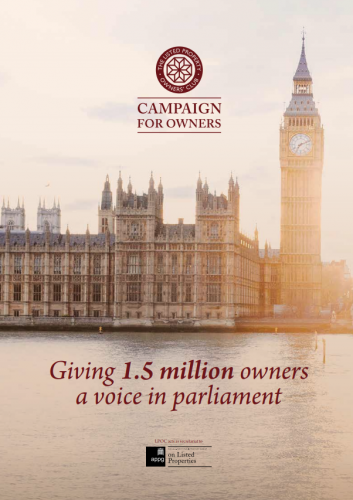OUR CAMPAIGN FOR OWNERS

Our campaign is a grassroots movement that depends on its members. We need all our members to get involved in our efforts by writing letters, attending meetings and creating groups in their local area. This will force politicians at all levels to take listed property owners seriously and have a position on our issues. There are over 1.5 million people who are directly affected by listed buildings, a huge group of voters that is presently not being represented. The Club is the only organisation that is campaigning for owners and giving you a voice in Westminster.
Listed property owners have faced real challenges in the past years. We lost our historic VAT benefits in 2012, some owners are being pursued for chancel repairs and flood damage has become more and more common. There is no public assistance to support private owners, and yet the government demands that we maintain our homes to their satisfaction. Most politicians are keen to ignore listed buildings and the challenges owners face today, content to penalise constituents who own historic properties.
We all agree this seems unbelievably unfair, but it is probably our own fault as we have never had representation in government to fight our corner. This has now all changed.
Working with 52 MP’s under the chairmanship of Craig Mackinlay, MP for South Thanet, we have created the All-Party Parliamentary Group (APPG) on Listed Properties to provide owners with a voice in Westminster, with similar organisations in Holyrood and the Senedd.
When we lost the VAT benefits, churches were provided with extra funding to compensate, when English Heritage divided into two organisations £80 million of tax payers money was made available to bring certain buildings up-to-date and up to £5,000 was made available for each of 6,500 homes that suffered damage in the recent floods. (As the £1 billion cost of repairing the flood damage carried VAT, contributing £200 million to the government, a payment of £32.5 million seems rather insignificant).
WE NEED YOUR HELP
As you can imagine this task is very expensive which is why we need your help. We’re not asking you for money but if you could give some thought to moving your home insurance to the Club’s providers they will pass an introductory fee back to us and it is this fee that will finance our efforts. As the policies they offer provide an exceptional combination of reasonable cost and comprehensive cover, it’s a true win/win situation.
If you would like to talk to our insurance team, call us on 01795 844939, or let us know your current policy’s renewal date by clicking here, and we’ll contact you at the appropriate time.
Please scroll down for detailed information on our Campaign for Owners. You can also contact our Campaign Officer on 01795 844939 or by email at campaign@lpoc.co.uk.
OUR CAMPAIGN IN 2019
Our campaign has been running since 2012, after the treasury unilaterally revoked the VAT relief on approved alterations that had been helping owners to maintain their buildings for decades. We realised that owners needed to become politically active if we wanted our voices to be heard in government.
Our campaign has grown substantially since it’s inception and now includes a wide range of issues. The tax increase inspired us to create a campaign but planning and regulations have long been a challenge for owners and so have also become a major part of our lobbying efforts.
We now operate at all levels of British politics, across the whole UK. We are constantly pursuing new avenues to pressure government and ensure listed building owners are supported. To see what the campaign is doing for you, you can read our guide to campaigning.
To request a printed copy of the Guide to Our Campaign, please call the club on 01795 844939.
ABOUT THE CAMPAIGN
The campaign has now reached a seven-year milestone, and during those years, we have been tirelessly lobbying MPs and Ministers for changes to benefit you as listed building owners.
Listed buildings face a wide range of challenges, including both legislative inaction and tough regulations. Get more information about the issues out campaign is focused on, and read our latest policy documents.
Our campaign guide explains our efforts to lobby government at the national, regional and local levels as well as the issues we are seeking reform on.
Click here to find out more on the latest news and updates for LPOC’s political campaign for owners, and have your say in our comments.
CAMPAIGN ISSUES
VAT RELIEF
The shock removal of the VAT exemption on listed building alterations in 2012 has had a huge impact on owners. The increase in costs led to an immediate drop in the number of owners carrying out approved works to their property. We aim to reduce VAT to 5% on repair, maintenance and approved alterations to make owning a listed building more affordable and ensure they are preserved for years to come.
LISTED BUILDING CONSENT
The present listed building consent process comes with long delays and high costs. It can take months to gain consent and often only after spending a significant sum to produce the supporting documents required. We are lobbying for a streamlined system that would be more proportional to the works being undertaken, and as a result would reduce red tape and improve efficiency.
COUNCIL RESOURCING
Local councils have faced major reductions in resources in the past decade which has hurt their ability to deliver a quality planning service. This has had a huge impact on listed building owners, who need to work with their local planning authority more frequently than any other type of property owner. We are campaigning for improved council funding, and ring-fenced resources for conservation officers and planning services.
CURTILAGE REFORM
The present listing system leaves many buildings in legal limbo, with no clear answer if they are protected or not. This can have a major impact on owners, often forcing them to assume all outbuildings and structures are listed and incurring significant costs to maintain and alter them. We are campaigning for enhanced listing to become cheaper and more available, to give owners certainty.
WILDLIFE SURVEYS
Over the past decade planning authorities have become increasingly stringent in their requests for wildlife surveys, particularly for listed buildings. This is a result of unclear legal guidance that leads councils to be overly cautious in their interpretation. We are asking for improved guidance to be issued to clarify where surveys are needed.
UNAUTHORISED ALTERATIONS
Unauthorised alterations made by previous owners are a major worry for all listed building owners. They can present a significant financial challenge when they are discovered no matter when they were made. We are campaigning for common sense reforms that would protect owners from being held responsible for previous unauthorised works.
Have you been struggling with any of these issues? Contact the club on 01795 844939 for advice and support.
You can share your story here, which helps us build evidence for change and put pressure on government.
ABOUT THE APPG

The All-Party Parliamentary Group (APPG) on Listed Properties was created after tireless campaigning by the Club. Realising we needed a strong voice in Parliament speaking up for listed property owners we worked with sympathetic MPs from all parties to help establish the Group. Craig Mackinlay, the MP for South Thanet, chairs the Group.
The APPG’s mission is speak up for listed properties in the UK and raise awareness in Parliament of the role played by their owners in protecting the nation’s heritage; to advocate policies that support owners in preserving listed properties including tax and planning reform.
Now the Club acts as its Secretariat, providing the MPs with evidence of the challenges of owning a listed property, organising meetings and opportunities for owners to meet MPs and Ministers and put the case for reform. A recent highlight was a meeting with Heritage Minister Michael Ellis during which members outlined the costs and concerns created by the planning postcode lottery.
I am delighted that the All-Party Parliamentary Group (APPG) is working with LPOC in campaigning for vital reforms that will help listed property owners. The APPG on Listed Properties has already won strong support from across all parties and it will provide a powerful voice in Parliament, raising the challenges listed property owners face and pressing for necessary reforms.
CRAIG MACKINLAY MP (CHAIR)
LIST OF APPG MEMBERS
| MP’s & Peers | Constituency | Party |
|---|---|---|
| Craig Macklinlay MP (Chair) | South Thanet | Con |
| Sir David Amess MP | Southend West | Con |
| Sir Peter Bottomley MP | Worthing West | Con |
| Andrew Rosindell MP | Romford | Con |
| Peter Aldous MP | Waveney | Con |
| John Penrose MP | Weston-Super-Mare | Con |
| Helen Goodman MP | Bishop Auckland | Lab |
| Philip Davies MP | Shipley | Con |
| Oliver Colvile MP | Plymouth, Sutton and Devonport | Con |
| William Wragg MP | Hazel Grove | Con |
| Cat Smith MP | Lancaster and Fleetwood | Lab |
| Bill Wiggin MP | North Herefordshire | Con |
| Karen Buck MP | Westminster North | Lab |
| Christopher Chope MP | Christchurch | Con |
| Bernard Jenkin MP | Harwich & North Essex | Con |
| Rt Hon Frank Field MP | Birkenhead | Lab |
| Caroline Nokes MP | Romsey & Southampton North | Con |
| Johny Mercer MP | Plymouth Moor View | Con |
| Edward Argar MP | Charnwood | Con |
| Wendy Morton MP | Aldridge Brownhills | Con |
| Andrew Bridgen MP | North West Leicestershire | Con |
| Damian Collins MP | Folkestone & Hythe | Con |
| Luke Hall MP | Thornbury & Yate | Con |
| Ruth Smeath MP | Stoke on Trent North | Lab |
| Steve Baker MP | Wycombe | Con |
| Craig Whitaker MP | Calder Valley | Con |
| MP’s & Peers | Constituency | Party |
|---|---|---|
| Guto Bebb MP | Aberconwy | Con |
| John Whittingdale MP | Maldon | Con |
| Rehman Chishti MP | Gillingham & Rainham | Con |
| Stephen McPartland MP | Stevenage | Con |
| Oliver Dowden MP | Hertsmere | Con |
| Gareth Johnson MP | Dartford | Con |
| Andrew Murrison MP | South West Wiltshire | Con |
| John Howell MP | Henley | Con |
| Sheryl Murray MP | South East Cornwall | Con |
| Kevin Hollinrake MP | Thirsk and Malton | Con |
| Rt Hon Sir Oliver Heald MP | North East Hertfordshire | Con |
| Andrew Lewer MP | Northampton South | Con |
| Robert Courts MP | Witney | Con |
| Stephen Kerr MP | Stirling | Con |
| Geoffrey Cox QC MP | Torridge & West Devon | Con |
| Philip Dunne MP | Ludlow | Con |
| Brendan O’Hara MP | Argyll & Bute | SNP |
| Nick Herbert MP | Arundel & South Downs | Con |
| Neil Parish MP | Tiverton and Honiton | Con |
| Lord Tope | Lib Dem | |
| Lord Leigh | Con | |
| Lord Dear | Con | |
| Lord Crathorne | Con | |
| Lord Lingfield | Con | |
| Baroness Young of Old Scone | Lab | |
| Rt Hon Lord Tebbit | Con |
WALES AND SCOTLAND


Listed buildings in Wales and Scotland face a slightly different control scheme than in England. There are many similarities, but new laws affecting listed buildings are now made in Holyrood and Cardiff. Over the past decade the laws have diverged somewhat as the devolved parliaments have legislated.
Despite these changes, there have not been any major reforms to the issues that affect listed building owners such as consent law, planning resources and pre-application paperwork.
Now that powers over these issues are devolved to their respective parliaments each government needs to be lobbied separately to create truly national change. We firmly believe that this works in our favour; increasing the number of lawmakers that we can approach.
Our campaigns in Wales and Scotland are particularly important because their parliaments are more approachable, which gives our campaign a far greater chance of success. Obviously this would deliver immediate benefits for our members in Wales and Scotland, but it will also serve as proof that our policies are workable and deliver the benefits we propose.
There are more than 100,000 listed buildings in Wales and Scotland, a significant proportion of all historic buildings. More importantly, over 250,000 people live in listed buildings, and these owners need to be supported and protected as well.
Welsh and Scottish listed buildings all fall under their own parliaments and legal systems, and so they need their own campaigns. Only Holyrood and the Senedd can provide the reforms owners need, and we are committed to lobbying for them.
Our first goal in both Wales and Scotland is to find champions in the legislatures and establish lines of communication through cross party groups. Just as in Westminster, this will give us the opportunity to discuss policy and ask parliamentary questions.
We are also working with Historic Environment Scotland and Cadw to contribute to official policy discussions, as well as with council officers to understand their unique challenges. Through the past year we have gained a huge amount of ground in Wales and Scotland and look forward to some real successes in the coming year.
SUPPORT THE CAMPAIGN
To be successful our campaign needs to reach as many people as possible, particularly the elected officials who can make a real difference on the issues that affect us as listed building owners.
We need your help to spread our message, to tell us what issues matter to you, and to build evidence of the challenges you face.
WRITE TO YOUR REPRESENTATIVES
Writing to your MP, MSP, AM or council gives you an opportunity to tell them what matters to you. Your letters bring attention to listed buildings, and that our issues are on the political agenda. Taking the time to write shows your representatives that listed buildings matter to you. Read our letter writing guide.
GATHER SUPPORT
The Club is the only organisation that represents the community of listed building owners. The more members we have the bigger the influence that we have when meeting with MPs and ministers, so recommend your friends and neighbours to us. Every member makes a difference. Click here to join the Club and show your support, or call us on 01795 844939.
START A LOCAL GROUP
A local group can bring together listed building owners with family, friends and the general public to boost our message and show how important listed buildings are to our communities. Even small groups can have a huge impact on a local level by writing letters and attending meetings. Working together helps our message to spread and shows a united front.
SUPPORT THE CLUB
Another way to support the Club is to use our insurance providers for your home. They offer comprehensive cover at a reasonable price, and your support helps our campaign. If you would like to talk to our insurance team, call us on 01795 844939, or let us know your current policy’s renewal date by clicking here, and we’ll contact you at the appropriate time.
SHARE YOUR STORIES
The personal impact of policies can be lost behind a wall of statistics, so we want to hear about your experiences as a listed building owner. Sharing your story helps us to personalise the issues when we speak with MPs and illustrate how their policies are effecting real people. Share your stories here or email us at campaign@lpoc.co.uk.
KEEP FIGHTING
The longer that we keep campaigning the more support we build; the greater the pressure that we can exert and the more fronts we can work on. Change takes time, but the only way to succeed is to not give up so keep fighting.
To support the campaign call us on 01795 844939 or e-mail campaign@lpoc.co.uk
CAMPAIGN NEWS
The full news and analysis from our campaign are in each edition of Listed Heritage, our bi-monthly 155 page magazine published for our members.
You can stay up to date with the headlines from our campaign below, and click here to sign up for our monthly newsletter.

